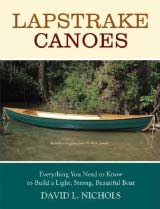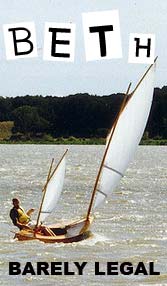
 Custom Search
|
|
| sails |
| plans |
| epoxy |
| rope/line |
| hardware |
| canoe/Kayak |
| sailmaking |
| materials |
| models |
| media |
| tools |
| gear |
 |
 |
| join |
| home |
| indexes |
| classifieds |
| calendar |
| archives |
| about |
| links |
| Join Duckworks Get free newsletter Comment on articles CLICK HERE |
|
|
| Propulsia |
by Tim Ferguson – Thetford, Vermont - USA |
The New PaddleWhen my plastic paddle broke, I found myself looking at the substantial ferule of my basswood treesaw.
I looked around for some description of what a paddle blade should look like and came up with Michael Storer’s free plans at my favorite web site, Duckworks.
I cut out the first blade from 4mm marine plywood before I realized the dimensions were offset from a center line.
Now all I had to do was cut the basswood pole ends and fit in the paddles.
First blade fitted hiding the roughness of the tablesaw work.
I found another double paddle so my canoeing didn’t have to wait for my woodworking.
At this point in the project it occurred to me that I was building a very different paddle from what Michael Storer describes in his plans. I wanted to give him credit for the part of his plans I had lifted, but I didn’t want to be a builder that made all sorts of changes then was unhappy with the designer. I wrote Michael and asked him what he thought about it. Here is his reply which includes my letter to him. I’ve thrown in the odd photo and spelling corrections to my original letter. I didn’t trust my spell checker with Michael’s Australian English. Begin - Michael Storer’s Letter Hi Tim, Sorry about the slow reply. Actually I don't mind the sort of experimenting with details - particularly with the paddles. Outriggers could be fooled around with a bit too, but it is good to talk to me in that case as it influences the boat behaviour. I don't like messing around with my boat designs except in areas of woodwork or with sensible consultation with me. I have a history of helping people making good decisions in the way of sensible changes. Like Clint Chase's yawl version of the Goat Island Skiff rig. I didn't like the extra complication so much, but I could see his point and he did it very nicely and checked his calcs for boat balance with me etc. With my boats, they are all pushed out to the edges of possibilities in different ways. With the Goat it was to see how simple and light a near 16 footer could be - most changes will make it heavier and more complicated and make it difficult for two people to move it around on land. With the OZ racer (formerly the Oz PDR) the idea was to keep the boat in the confines of three sheets of ply while trying to maximise performance. Changes there will increase the ply budget by 25% and can only add weight, making it hard for the regular sailor's kids or grandkids to get the boat down to the water by themselves. I've put replies through your text below. Hi Michael, I imagine that people making changes to your excellent designs is the bane of your existence. So let me tell you what I've done and you tell me what you'd like me to say or not say about it in an article I'm writing for Duckworks. Thanks for that Tim! Appreciate the thought. Feel free to use my drawings of the paddles from my website in your article. And any text from here. The idea of them originally was to produce a light and pretty single and double paddle design that was kind of classic, but with simplified blades. The only real choice for simplified blades was plywood as it is light and hugely strong. Also many builders have a bit on hand. The double paddle was from a design by Francis Herreshoff and is from an era when high cadences were not considered important and the idea was mostly paddling on rivers and lakes and "double paddle canoes" and kayaks were wider and higher than now. So compared to modern designs the double paddle was longer with smaller blades. A number of people have modified the double paddle to have a shorter shaft, more like a modern geometry - keep the centre section where you hold it at the ends and the area the blades attach the same, but shorten the areas between. It is a very pretty paddle and looks very nice if carefully made. The single blade design came from scouring a bunch of canoeing magazines including paddle reviews etc. Some have altered it with different blade shapes and sizes and also made it with flat blades for turning and a more stable in-water paddle behaviour. The other purpose of the plan was to introduce a bunch of general boatbuilding and epoxy methods in a non scary way. Lots of people are scared of laminating, for example. I was looking for a quick and dirty way to make a double paddle. (Maxim: Everything quick and dirty is less quick and more dirty). I started looking at my tree saw, an 12 foot long bass wood pole with a substantial breakdown ferule in the middle). I thought such a ferule would be a lovely way to have a double paddle I could throw into the car's trunk instead of lashing it onto the overhead roof rack. When I considered how little tree work I do these days, I decided to cut down my saw pole to the 102 inch (if I did the conversion right) length you suggest and fit blades into it. It can be much better to have a square piece of timber to start with if needing to taper the shaft to remove weight and give a bit more "spring" to the paddle - it is just easier to get the paddles square and neatly located.
But if it is just about getting a paddle quickly ... I agree. We did a similar thing with our paddles we just used in France - we built two Quick Canoes in a week and then paddled them down the Loire in a week. Article/s coming soon! This is where I want your judgment call. I know curved blades work better. All I have to do is look at how my hand is shaped when I catch each stroke of the old Australian Crawl. In the interest of quick and dirty, I used your double paddle blade dimensions without curving the plywood. 4mm plywood - I'm in a hurry - no end of excuses. To tell you the truth, the amount of curve on the blades doesn't make a huge amount of difference. If you look at real competitive racing blades they are really deeply sculpted. A little bit of curve is not going to make a world of difference. However I can see how it fits with your purpose. The paddle will make a little bit more of a splash when it enters the water and will have slightly less power for its area. But we are talking very few percentage points here. Here's the background for my question. I'm writing a Duckworks article about propulsion of a canoe for the boating I've been doing all summer. I want to include pictures of the paddle I'm making. That is cool. Should I mention that I got the dimensions from your free paddle plans especially since I'm using them flat instead of your superior (but harder to make) curved blades? I want to do show and tell in the worst way, but don't want to misrepresent your work. Include the parts of the comments I've made that you feel are relevant about the limits of changing things or useful to the reader. Or you could possibly just have your email and this reply at the bottom of the article. Whatever suits. I just bought a set of your drop in outrigger plans. The thought of turning my poky beat up 25 year old canoe into a fast trimaran delights my heart. Be assured that I would work in metric and not make any changes! Thanks Tim ... that made me laugh. "Raise your right hand, place your left on this metric tape measure and repeat after me ..."
Do you know I have a free supplement for the outriggers that gives a flatter arch to the crossbeams for boats where the freeboard is lower and also suggests dimensions and attachment of spars? Even a basic polytarp sail design. Give me a yell if you want it. Best wishes End - Michael Storer’s letter. Now I have a paddle I’m happy with. I took it out unfinished once last fall before the water froze and it worked beautifully.
I built up the blade tips so I could pole in shallow rocky water.
I repaired my funky table saw work with a saw dust epoxy mixture. Looking for further fairing, I used some wood putty which gave the blades their racing stripes.
The final paddle has a slight bend over its length which I didn’t intend but like the feel of. Years ago a windstorm threw the canoe against a tree. Got that repaired this year. Didn’t someone say “small project” is an oxymoron?
Now to make Storer’s drop in outriggers.
|
 |
